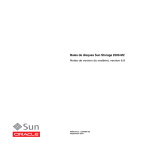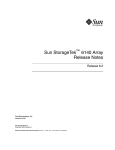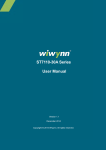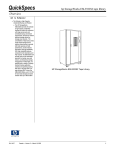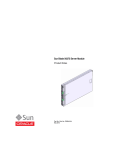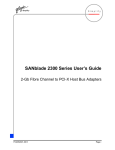Download Sun Storage 2500-M2 Arrays
Transcript
Sun Storage 2500-M2 Arrays
Hardware Release Notes, Release 6.9.x
Part No.: E24025-02
February 2012
Copyright © 2011, 2012, Oracle and/or its affiliates. All rights reserved.
This software and related documentation are provided under a license agreement containing restrictions on use and disclosure and are protected by
intellectual property laws. Except as expressly permitted in your license agreement or allowed by law, you may not use, copy, reproduce, translate,
broadcast, modify, license, transmit, distribute, exhibit, perform, publish, or display any part, in any form, or by any means. Reverse engineering,
disassembly, or decompilation of this software, unless required by law for interoperability, is prohibited.
The information contained herein is subject to change without notice and is not warranted to be error-free. If you find any errors, please report them to us
in writing.
If this is software or related software documentation that is delivered to the U.S. Government or anyone licensing it on behalf of the U.S. Government, the
following notice is applicable:
U.S. GOVERNMENT RIGHTS. Programs, software, databases, and related documentation and technical data delivered to U.S. Government customers
are "commercial computer software" or "commercial technical data" pursuant to the applicable Federal Acquisition Regulation and agency-specific
supplemental regulations. As such, the use, duplication, disclosure, modification, and adaptation shall be subject to the restrictions and license terms set
forth in the applicable Government contract, and, to the extent applicable by the terms of the Government contract, the additional rights set forth in FAR
52.227-19, Commercial Computer Software License (December 2007). Oracle America, Inc., 500 Oracle Parkway, Redwood City, CA 94065.
This software or hardware is developed for general use in a variety of information management applications. It is not developed or intended for use in any
inherently dangerous applications, including applications which may create a risk of personal injury. If you use this software or hardware in dangerous
applications, then you shall be responsible to take all appropriate fail-safe, backup, redundancy, and other measures to ensure its safe use. Oracle
Corporation and its affiliates disclaim any liability for any damages caused by use of this software or hardware in dangerous applications.
Oracle and Java are registered trademarks of Oracle and/or its affiliates. Other names may be trademarks of their respective owners.
AMD, Opteron, the AMD logo, and the AMD Opteron logo are trademarks or registered trademarks of Advanced Micro Devices. Intel and Intel Xeon are
trademarks or registered trademarks of Intel Corporation. All SPARC trademarks are used under license and are trademarks or registered trademarks of
SPARC International, Inc. UNIX is a registered trademark licensed through X/Open Company, Ltd.
This software or hardware and documentation may provide access to or information on content, products, and services from third parties. Oracle
Corporation and its affiliates are not responsible for and expressly disclaim all warranties of any kind with respect to third-party content, products, and
services. Oracle Corporation and its affiliates will not be responsible for any loss, costs, or damages incurred due to your access to or use of third-party
content, products, or services.
Copyright © 2011, 2012 Oracle et/ou ses affiliés. Tous droits réservés.
Ce logiciel et la documentation qui l’accompagne sont protégés par les lois sur la propriété intellectuelle. Ils sont concédés sous licence et soumis à des
restrictions d’utilisation et de divulgation. Sauf disposition de votre contrat de licence ou de la loi, vous ne pouvez pas copier, reproduire, traduire,
diffuser, modifier, breveter, transmettre, distribuer, exposer, exécuter, publier ou afficher le logiciel, même partiellement, sous quelque forme et par
quelque procédé que ce soit. Par ailleurs, il est interdit de procéder à toute ingénierie inverse du logiciel, de le désassembler ou de le décompiler, excepté à
des fins d’interopérabilité avec des logiciels tiers ou tel que prescrit par la loi.
Les informations fournies dans ce document sont susceptibles de modification sans préavis. Par ailleurs, Oracle Corporation ne garantit pas qu’elles
soient exemptes d’erreurs et vous invite, le cas échéant, à lui en faire part par écrit.
Si ce logiciel, ou la documentation qui l’accompagne, est concédé sous licence au Gouvernement des Etats-Unis, ou à toute entité qui délivre la licence de
ce logiciel ou l’utilise pour le compte du Gouvernement des Etats-Unis, la notice suivante s’applique :
U.S. GOVERNMENT RIGHTS. Programs, software, databases, and related documentation and technical data delivered to U.S. Government customers
are "commercial computer software" or "commercial technical data" pursuant to the applicable Federal Acquisition Regulation and agency-specific
supplemental regulations. As such, the use, duplication, disclosure, modification, and adaptation shall be subject to the restrictions and license terms set
forth in the applicable Government contract, and, to the extent applicable by the terms of the Government contract, the additional rights set forth in FAR
52.227-19, Commercial Computer Software License (December 2007). Oracle America, Inc., 500 Oracle Parkway, Redwood City, CA 94065.
Ce logiciel ou matériel a été développé pour un usage général dans le cadre d’applications de gestion des informations. Ce logiciel ou matériel n’est pas
conçu ni n’est destiné à être utilisé dans des applications à risque, notamment dans des applications pouvant causer des dommages corporels. Si vous
utilisez ce logiciel ou matériel dans le cadre d’applications dangereuses, il est de votre responsabilité de prendre toutes les mesures de secours, de
sauvegarde, de redondance et autres mesures nécessaires à son utilisation dans des conditions optimales de sécurité. Oracle Corporation et ses affiliés
déclinent toute responsabilité quant aux dommages causés par l’utilisation de ce logiciel ou matériel pour ce type d’applications.
Oracle et Java sont des marques déposées d’Oracle Corporation et/ou de ses affiliés.Tout autre nom mentionné peut correspondre à des marques
appartenant à d’autres propriétaires qu’Oracle.
AMD, Opteron, le logo AMD et le logo AMD Opteron sont des marques ou des marques déposées d’Advanced Micro Devices. Intel et Intel Xeon sont des
marques ou des marques déposées d’Intel Corporation. Toutes les marques SPARC sont utilisées sous licence et sont des marques ou des marques
déposées de SPARC International, Inc. UNIX est une marque déposée concédée sous licence par X/Open Company, Ltd.
Ce logiciel ou matériel et la documentation qui l’accompagne peuvent fournir des informations ou des liens donnant accès à des contenus, des produits et
des services émanant de tiers. Oracle Corporation et ses affiliés déclinent toute responsabilité ou garantie expresse quant aux contenus, produits ou
services émanant de tiers. En aucun cas, Oracle Corporation et ses affiliés ne sauraient être tenus pour responsables des pertes subies, des coûts
occasionnés ou des dommages causés par l’accès à des contenus, produits ou services tiers, ou à leur utilisation.
Please
Recycle
Sun Storage 2500-M2 Arrays
Hardware Release Notes
This document contains important release information about Oracle’s Sun Storage
2500-M2 Arrays managed by Sun Storage Common Array Manager (CAM), Version
6.9.0. Read this document so that you are aware of issues or requirements that can
affect the installation and operation of the array.
The release notes consist of the following sections:
■
“What’s New for This Release” on page 2
■
“Product Overview” on page 2
■
“About the Management Software” on page 3
■
“Downloading Patches and Updates” on page 3
■
“System Requirements” on page 4
■
“Device Mapper Multipath (DMMP) for the Linux Operating System” on page 13
■
“Restrictions and Known Issues” on page 21
■
“Related Documentation” on page 27
■
“Documentation, Support, and Training” on page 28
1
What’s New for This Release
Firmware version 7.80.xx.x delivered with CAM 6.9 adds these features to Sun
Storage 2500-M2 arrays:
■
■
■
■
Expanded features:
■
Support for 96 drives (7 expansion trays)
■
Performance Enhancer (increases performance of the base controller)
Data Services support:
■
Snapshot license (up to 128 snapshots per array, 8 per volume) with Snapshot
Rollback
■
Volume Copy license (up to 255 per array)
■
Storage Domains license (up to 32 per array)
Data host support for:
■
Oracle Linux 6.0, 5.6, 5.5 Fibre Channel
■
Oracle Unbreakable Linux
■
Oracle VM 2.2.2 (2540-M2 only)
■
RedHat Linux 6.0, 5.6, 5.5 (2530-M2 and 2540-M2)
■
SuSe Linux 11.1, 10.4, 10 SP3
■
Windows 2003 SP2 R2 clustered and non-clustered
■
Windows Server 2008 R2 SP1 clustered and non-clustered
Sun Storage Common Array Manager enhancements (as described in the CAM
Release Notes)
Product Overview
The Sun Storage 2500-M2 Arrays are a family of storage products that provide highcapacity, high-reliability storage in a compact configuration. The controller tray, with
two controller modules, provides the interface between a data host and the disk
drives. Three array models are offered:
2
■
The Sun Storage 2540-M2 array provides a Fibre Channel (FC) connection
between the data host and the controller tray at 8 Gbit/sec.
■
The Sun Storage 2530-M2 array provides a Serial Attached SCSI (SAS) connection
between the data host and the controller tray at 6 Gbit/sec.
Sun Storage 2500-M2 Arrays Hardware Release Notes • February 2012
■
The Sun Storage 2501-M2 array expansion tray provides additional storage via
SAS interface at 6 Gbit/sec. It is connected to either of the above controller tray
models.
The Sun Storage 2500-M2 Arrays are modular and rack-mountable in industrystandard cabinets. The arrays are scalable from a single controller tray configuration
to a maximum configuration of one controller tray and three expansion trays. The
maximum configuration creates a storage array configuration with a total of 48
drives attached behind the controllers.
Use the latest version of Sun Storage Common Array Manager to manage the arrays.
See “About the Management Software” on page 3 for more information.
About the Management Software
Oracle’s Sun Storage Common Array Manager (CAM) software is a key component
for the initial configuration and operation of Sun Storage 2500-M2 Arrays hardware.
It is installed on a management host cabled to the array via out-of-band Ethernet.
Note: In-band management is also supported.
To download CAM, follow the procedure in the section “Downloading Patches and
Updates” on page 3. Then, review the latest Sun Storage Common Array Manager
Quick Start Guide and Sun Storage Common Array Manager Installation and Setup Guide
to begin installation. CAM documentation can be found here:
http://www.oracle.com/technetwork/documentation/disk-device194280.html
Downloading Patches and Updates
To download patches and updates from My Oracle Support, including the CAM
management software, follow this procedure.
1. Sign in to My Oracle Support:
https://support.oracle.com
2. At the top of the page, click the Patches & Updates tab.
3. Search for software and patches in one of two ways:
■
If you have a patch number:
Sun Storage 2500-M2 Arrays Hardware Release Notes
3
a. Under the Patch Search section, click the Search tab.
b. In the Patch Name or Number field, enter the patch number. For example,
10272123 or 141474-01.
c. Click Search.
■
If you do not have a patch number:
a. Under the Patch Search section, click the Search tab, and then click the
Product or Family (Advanced Search) link.
b. Check Include all products in a family.
c. In the Product field, start typing the product name. For example, “Sun
Storage Common Array Manager (CAM)”.
Select the product name when it appears.
d. In the Release field, expand the product name, check the release and patches
you want to download, and then click Close.
e. Click Search.
4. Select the patch you want to download.
5. Click ReadMe for a patch description and installation instructions.
6. Click Download for a single patch, or Add to Plan to download a group of
patches.
System Requirements
The software and hardware products that have been tested and qualified to work
with Sun Storage 2500-M2 Arrays are described in the following sections. Sun
Storage 2500-M2 Arrays require Sun Storage Common Array Manager, Version 6.8.0
(or higher) software.
4
■
“Firmware Requirements” on page 5
■
“Supported Disk Drives and Tray Capacity” on page 5
■
“Array Expansion Module Support” on page 5
■
“Data Host Requirements” on page 6
Sun Storage 2500-M2 Arrays Hardware Release Notes • February 2012
Firmware Requirements
The Sun Storage 2500-M2 Arrays firmware version 07.80.xx.xx (or higher) is installed
on the array controllers prior to shipment and is also delivered with Sun Storage
Common Array Manager (CAM), Version 6.9.0.
Firmware is bundled with the CAM software download package. To download
CAM, follow the procedure in “Downloading Patches and Updates” on page 3.
Supported Disk Drives and Tray Capacity
TABLE 1 lists the disk capacity, form factor, spindle speed, interface type, interface
speed, and tray capacity for supported SAS disk drives for the Sun Storage 2500-M2
arrays.
TABLE 1
Supported Disk Drives
Drive
Description
SAS-2, 300G15K
300-Gbyte 3.5" 15K-RPM SAS-2 drives
(6 Gbits/sec); 3600 Gbytes per tray
SAS-2, 600G15K
600-Gbyte 3.5” 15K-RPM SAS-2 drives
(6 Gbits/sec); 7200 Gbytes per tray
Array Expansion Module Support
The Sun Storage 2530-M2 and 2540-M2 arrays can be expanded by adding Sun
Storage 2501-M2 array expansion trays. To add capacity to an array, refer to the
following Service Advisor procedures:
■
Adding Expansion Trays
■
Upgrade Firmware
Caution – To add trays with existing stored data, contact My Oracle Support for
assistance to avoid data loss.
TABLE 2
IOM Code for Sun Storage 2501-M2 Expansion Tray
Array Controller
Firmware
Supported Expansion
Tray
IOM Code
Sun Storage 6180
07.80.51.10
2501-M2
0361
Sun Storage 2500-M2 Arrays Hardware Release Notes
5
Data Host Requirements
■
“Multipathing Software” on page 6
■
“Supported Host Bus Adaptors (HBAs)” on page 8
■
“Supported FC and Multilayer Switches” on page 12
Multipathing Software
TABLE 3 and TABLE 4 provide a summary of the data host requirements for the Sun
Storage 2500-M2 Arrays. You must install multipathing software on each data host
that communicates with the Sun Storage 2500-M2 Arrays. For additional information
on multipathing software, see the following:
■
Sun StorageTek RDAC Multipath Failover Driver Installation Guide For Linux OS
■
“Device Mapper Multipath (DMMP) for the Linux Operating System” on page 13
Note – Download RDAC multipathing drivers from My Oracle Support at
https://support.oracle.com using keyword “RDAC” or “MPP”. See
“Downloading Patches and Updates” on page 3 for more information.
Note – Single path data connections are not recommended. For more information,
see “Single Path Data Connections” on page 21.
TABLE 3
Supported Fibre Channel Multipathing Software
Multipathing
Software
OS
Minimum Version
5*
Host Type Setting
Notes
Solaris with
MPxIO
Multipathing software
included in Solaris OS 10
Solaris 10
STMS/MPxIO
Update
Oracle Linux 6.0, 5.6, 5.5
RDAC
09.03.0C02.0453
Unbreakable Linux
DMMP
Oracle VM 2.2.2
RDAC
RDAC version
09.03.0C02.0331
is included with
Oracle VM 2.2.2.
Linux
RHEL 6.0, 5.6, 5.5
RDAC
09.03.0C02.0453
Linux
SLES 10.4, 10 SP3
RDAC/MPP
09.03.0C02.0453
Linux
6
Linux
Unbreakable
Sun Storage 2500-M2 Arrays Hardware Release Notes • February 2012
Multipathing software
included in OS
TABLE 3
Supported Fibre Channel Multipathing Software (Continued)
OS
Multipathing
Software
Minimum Version
Host Type Setting
Notes
SLES 11.1
DMMP
----->
----->
See “Device Mapper
Multipath (DMMP) for the
Linux Operating System”
on page 13.
Windows 2003 SP2 R2
Non-clustered
MPIO
01.03.0302.0504
Windows 2003
Non-clustered
Windows 2003/2008
MSCS Cluster
MPIO
01.03.0302.0504
Windows Server
2003 Clustered
Windows 2008 R2 SP1
(64-bit only)
MPIO
01.03.0302.0504
Windows Server
2003
You must use MPIO for
7.10 and above
* Although the minimum is stated, Oracle recommends the latest update be installed.
TABLE 4
Supported SAS Multipathing Software
OS
Multipathing
Software
Minimum Version
Host Type Setting
Notes
Solaris 10
MPxIO
Update 9
Solaris with
MPxIO
Multipathing software
included in Solaris OS 10
Oracle Linux 5.5
RDAC
09.03.0C02.0453
Linux
RHEL 5.5
RDAC
09.03.0C02.0453
Linux
Windows 2008
Windows 2008 R2
MPIO
01.03.0302.0504
Windows clustered
Windows nonclustered
Windows 2003 SP2
MPIO
01.03.0302.0504
Windows clustered
Windows nonclustered
Sun Storage 2500-M2 Arrays Hardware Release Notes
7
Supported Host Bus Adaptors (HBAs)
■
HBAs must be ordered separately from Oracle or its respective manufacturers.
■
To obtain the latest HBA firmware:
■
For Fibre Channel HBAs, download firmware from My Oracle Support using
keyword “HBA”. For download instructions, see “Downloading Patches and
Updates” on page 3.
■
For SAS HBAs, go to http://www.lsi.com/support/sun/
■
You must install multipathing software before you install any OS patches.
■
Download OS updates from the web site of the OS company.
The following tables list supported HBAs by interface type and operating system:
TABLE 5
■
TABLE 5: Supported Fibre Channel HBAs for Solaris Data Host Platforms
■
TABLE 6: Supported Fibre Channel HBAs for Linux Data Host Platforms
■
TABLE 7: Supported Fibre Channel HBAs for Windows Data Host Platforms
■
TABLE 8: Supported SAS HBAs for Solaris and Linux Data Host Platforms
■
TABLE 9: Supported SAS HBAs for Microsoft Windows Data Host Platforms
Supported Fibre Channel HBAs for Solaris Data Host Platforms
Host OS
Oracle 2-Gbit HBAs
Oracle 4-Gbit HBAs
Oracle 8-Gbit HBAs
Solaris 10u5
(minimum)
SPARC
SG-XPCI1FC-QL2 (6767A)
SG-XPCI2FC-QF2-Z (6768A)
SG-XPCI1FC-EM2
SG-XPCI2FC-EM2
SG-XPCIE1FC-QF4
SG-XPCIE2FC-QF4
SG-XPCIE1FC-EM4
SG-XPCIE2FC-EM4
SG-XPCI1FC-QF4
SG-XPCI2FC-QF4
SG-XPCI1FC-EM4
SG-XPCI2FC-EM4
SG-XPCIE2FCGBE-Q-Z
SG-XPCIE2FCGBE-E-Z
SG-XPCIE1FC-QF8-Z
SG-XPCIE2FC-QF8-Z
SG-XPCIE1FC-EM8-Z
SG-XPCIE2FC-EM8-Z
SG-XPCIEFCGBE-Q8
SG-XPCIEFCGBE-E8
Solaris 10u5
(minimum)
x64/x86
SG-XPCI1FC-QL2 (6767A)
SG-XPCI2FC-QF2-Z (6768A)
SG-XPCI1FC-EM2
SG-XPCI2FC-EM2
SG-XPCIE1FC-QF4
SG-XPCIE2FC-QF4
SG-XPCIE1FC-EM4
SG-XPCIE2FC-EM4
SG-XPCI1FC-QF4
SG-XPCI2FC-QF4
SG-XPCI1FC-EM4
SG-XPCI2FC-EM4
SG-XPCIE2FCGBE-Q-Z
SG-XPCIE2FCGBE-E-Z
SG-XPCIE1FC-QF8-Z
SG-XPCIE2FC-QF8-Z
SG-XPCIE1FC-EM8-Z
SG-XPCIE2FC-EM8-Z
SG-XPCIEFCGBE-E8
SG-XPCIEFCGBE-Q8
8
Sun Storage 2500-M2 Arrays Hardware Release Notes • February 2012
TABLE 6
Supported Fibre Channel HBAs for Linux Data Host Platforms
Host OS
Generic HBAs*
Oracle 2-Gbit HBAs
Oracle 4-Gbit HBAs
Oracle 8-Gbit HBAs
Oracle Linux
5.5, 5.6, 6.0
QLogic:
QLE 256x
QLE 246x
QLA 246x
QLA 234x
QLA 2310F
Emulex:
LP982/LP9802/
9802DC
LP9002/LP9002DC/
LP952
LP10000/10000DC/
LP1050
Lpe11000/LPe11002/
LPe1150
Lpe12000/LPe12002/
LPe1250
SG-XPCI1FC-EM2
SG-XPCI2FC-EM2
SG-XPCI1FC-QL2
SG-XPCI2FC-QF2-Z
SG-XPCIE1FC-QF4
SG-XPCIE2FC-QF4
SG-XPCIE1FC-EM4
SG-XPCIE2FC-EM4
SG-XPCI1FC-QF4
SG-XPCI2FC-QF4
SG-XPCI1FC-EM4-Z
SG-XPCI2FC-EM4-Z
SG-XPCIE2FCGBE-Q-Z
SG-XPCIE2FCGBE-E-Z
SG-XPCIE1FC-QF8-Z
SG-XPCIE2FC-QF8-Z
SG-XPCIE1FC-EM8-Z
SG-XPCIE2FC-EM8-Z
SG-XPCIEFCGBE-Q8
SG-XPCIEFCGBE-E8
SLES
QLogic:
10.1, 10.4, 11, 11.1 QLE 256x
QLE246x
QLA 246x
QLA 234x
QLA 2310F
Emulex:
LP982/LP9802/
9802DC
LP9002/LP9002DC/
LP952
LP10000/10000DC/
LP1050
LP11000/LP11002/
LP1150
Lpe11000/LPe11002/
LPe1150/Lpe12000/
LPe12002/Lpe1250
SG-XPCI1FC-EM2
SG-XPCI2FC-EM2
SG-XPCI1FC-QL2
SG-XPCI2FC-QF2-Z
SG-XPCIE1FC-QF4
SG-XPCIE2FC-QF4
SG-XPCIE1FC-EM4
SG-XPCIE2FC-EM4
SG-XPCI1FC-QF4
SG-XPCI2FC-QF4
SG-XPCI1FC-EM4
SG-XPCI2FC-EM4
SG-XPCIE2FCGBE-Q-Z
SG-XPCIE2FCGBE-E-Z
SG-XPCIE1FC-QF8-Z
SG-XPCIE2FC-QF8-Z
SG-XPCIE1FC-EM8-Z
SG-XPCIE2FC-EM8-Z
SG-XPCIEFCGBE-E8
SG-XPCIEFCGBE-Q8
RHEL
5.5, 5.6, 6.0
Oracle VM
2.2.2
* For generic HBA support, contact the HBA manufacturer.
Sun Storage 2500-M2 Arrays Hardware Release Notes
9
TABLE 7
Host OS /
Servers
Microsoft
Windows
2008, R2
Server 32bit / x86
(IA32)
64-bit /
x64
(AMD)
EM64T
IA64
Microsoft
Windows
2003
32-bit with
SP2 R2 /
x86 (IA32)
10
Supported Fibre Channel HBAs for Windows Data Host Platforms
Generic HBAs*
Sun 2-Gb HBAs
Sun 4-Gb HBAs
Sun 8-Gb HBAs
QLogic:
QLE 256x
QLE 246x
QLA 246x
QLA 234x
QLA 2310F
Emulex:
LPe12000/LPe12002/
LPe1250
Lpe11000/LPe11002/LPe1150
LP11000/LP11002/LP1150
LP9802/9802DC/982
LP952/LP9002/LP9002DC
10000/10000DC/LP1050
SG-XPCI1FC-EM2
SG-XPCI2FC-EM2
SG-XPCI1FC-QL2
SG-XPCI2FC-QF2-Z
SG-XPCIE1FC-QF4
SG-XPCIE2FC-QF4
SG-XPCIE1FC-EM4
SG-XPCIE2FC-EM4
SG-XPCI1FC-QF4
SG-XPCI2FC-QF4
SG-XPCI1FC-EM4
SG-XPCI2FC-EM4
SG-XPCIE2FCGBE-Q-Z
SG-XPCIE2FCGBE-E-Z
SG-XPCIE1FC-QF8-Z
SG-XPCIE2FC-QF8-Z
SG-XPCIE1FC-EM8-Z
SG-XPCIE2FC-EM8-Z
SG-XPCIEFCGBE-Q8
SG-XPCIEFCGBE-E8
QLogic:
QLE 256x
QLE 246x
QLA 246x
QLA 234x
QLA 2310F
Emulex:
LPe12000/LPe12002/LPe1250
Lpe11000/LPe11002/LPe1150
LP11000/LP11002/LP1150
LP9802/9802DC/982
LP952/LP9002/LP9002DC
10000/10000DC/LP1050
SG-XPCI1FC-EM2
SG-XPCI2FC-EM2
SG-XPCI1FC-QL2
SG-XPCI2FC-QF2-Z
SG-XPCIE1FC-QF4
SG-XPCIE2FC-QF4
SG-XPCIE1FC-EM4
SG-XPCIE2FC-EM4
SG-XPCI1FC-QF4
SG-XPCI2FC-QF4
SG-XPCI1FC-EM4
SG-XPCI2FC-EM4
SG-XPCIE2FCGBE-Q-Z
SG-XPCIE2FCGBE-E-Z
SG-XPCIE1FC-QF8-Z
SG-XPCIE2FC-QF8-Z
SG-XPCIE1FC-EM8-Z
SG-XPCIE2FC-EM8-Z
SG-XPCIEFCGBE-E8
SG-XPCIEFCGBE-Q8
Sun Storage 2500-M2 Arrays Hardware Release Notes • February 2012
TABLE 7
Host OS /
Servers
Microsoft
Windows
2003
64-bit with
SP2 R2 /
x64
(AMD)
EM64T
IA64
Supported Fibre Channel HBAs for Windows Data Host Platforms (Continued)
Generic HBAs*
Sun 2-Gb HBAs
Sun 4-Gb HBAs
Sun 8-Gb HBAs
QLogic:
QLE 256x
QLE 246x
QLA 246x
QLA 234x
QLA 2310F
Emulex:
LPe12000/LPe12002/LPe1250
Lpe11000/LPe11002/LPe1150
LP11000/LP11002/LP1150
LP9802/9802DC/982
LP952/LP9002/LP9002DC
10000/10000DC/LP1050
SG-XPCI1FC-EM2
SG-XPCI2FC-EM2
SG-XPCI1FC-QL2
SG-XPCI2FC-QF2-Z
SG-XPCIE1FC-QF4
SG-XPCIE2FC-QF4
SG-XPCIE1FC-EM4
SG-XPCIE2FC-EM4
SG-XPCI1FC-QF4
SG-XPCI2FC-QF4
SG-XPCI1FC-EM4
SG-XPCI2FC-EM4
SG-XPCIE2FCGBE-Q-Z
SG-XPCIE2FCGBE-E-Z
SG-XPCIE1FC-QF8-Z
SG-XPCIE2FC-QF8-Z
SG-XPCIE1FC-EM8-Z
SG-XPCIE2FC-EM8-Z
SG-XPCIEFCGBE-Q8
SG-XPCIEFCGBE-E8
* For generic HBA support, contact the HBA manufacturer.
TABLE 8
Supported SAS HBAs for Solaris and Linux Data Host Platforms
Host OS
Oracle 3-Gbit HBAs (SAS-1)*
Oracle 6-Gbit HBAs (SAS-2)†
Solaris 10u9 (minimum)
Oracle Linux 5.5
RHEL 5.5
SG-XPCIE8SAS-E-Z
SG-XPCIE8SAS-EB-Z
SG(X)-SAS6-EXT-Z
SG(X)-SAS6-EM-Z
* See “SAS-1 HBA Settings” on page 12
† See “Restrictions” on page 21
TABLE 9
Supported SAS HBAs for Microsoft Windows Data Host Platforms
Host OS
Windows 2008
Windows 2008 R2
Windows 2003 SP2*
Oracle 3-Gbit HBAs (SAS-1)
SG-XPCIE8SAS-E-Z
†
Oracle 6-Gbit HBAs (SAS-2)
SG(X)-SAS6-EXT-Z‡
* Not supported with SAS-2 HBAs.
† With firmware 1.30.04.00 (phase 17). See http://www.lsi.com/sep/Pages/oracle/sg_xpci8sas_e_sRoHS.aspx
‡ With firmware 2.00.29.00 (phase 5 ++). See http://www.lsi.com/sep/Pages/oracle/sg_x_sas6-int-ext-em-z.aspx
Sun Storage 2500-M2 Arrays Hardware Release Notes
11
SAS-1 HBA Settings
TABLE 10 lists supported HBA settings for SAS-1 HBA compatibility.
Configuration: Firmware 01.29.06.00-IT with NVDATA 2DC5, BIOS 6.28.00.00,
FCode 1.00.49.
TABLE 10
SAS-1 HBA Settings
Host OS
Settings
Solaris 10u9, SPARC
HBA defaults
Solaris 10u9, x86
IODeviceMissingDelay 20
ReportDeviceMissingDelay 20
Oracle Linux 5.5
RHEL 5.5
IODeviceMissingDelay 8
ReportDeviceMissingDelay 144
Supported FC and Multilayer Switches
The following FC fabric and multilayer switches are compatible for connecting data
hosts and the Sun Storage 2540-M2 array. See the release notes for your switch
hardware for firmware support information.
12
■
Brocade SilkWorm 200E/300/4100/4900/5000/5100/5300/7500/48000/DCX
■
Cisco 9124/9134/9216/9216i/9222i/9506/9509/9513
■
QLogic SANBox 5602/9000
Sun Storage 2500-M2 Arrays Hardware Release Notes • February 2012
Device Mapper Multipath (DMMP) for
the Linux Operating System
Device Mapper (DM) is a generic framework for block devices provided by the
Linux operating system. It supports concatenation, striping, snapshots, mirroring,
and multipathing. The multipath function is provided by the combination of the
kernel modules and user space tools.
The DMMP is supported on SUSE Linux Enterprise Server (SLES) Version 11 and
11.1. The SLES installation must have components at or above the version levels
shown in the following table before you install the DMMP.
TABLE 11
Minimum Supported Configurations for the SLES 11 Operating System
Version
Component
Kernel version
kernel-default-2.6.27.29-0.1.1
Scsi_dh_rdac kmp
lsi-scsi_dh_rdac-kmp-default0.0_2.6.27.19_5-1
Device Mapper library
device-mapper-1.02.27-8.6
Multipath-tools
multipath-tools-0.4.8-40.6.1
To update a component, download the appropriate package from the Novell website
at http://download.novell.com/patch/finder. The Novell publication, SUSE
Linux Enterprise Server 11 Installation and Administration Guide, describes how to
install and upgrade the operating system.
Device Mapper Features
■
Provides a single block device node for a multipathed logical unit
■
Ensures that I/O is re-routed to available paths during a path failure
■
Ensures that the failed paths are revalidated as soon as possible
■
Configures the multipaths to maximize performance
■
Reconfigures the multipaths automatically when events occur
■
Provides DMMP features support to newly added logical unit
■
Provides device name persistency for DMMP devices under /dev/mapper/
■
Configures multipaths automatically at an early stage of rebooting to permit the
OS to install and reboot on a multipathed logical unit
Sun Storage 2500-M2 Arrays Hardware Release Notes
13
Known Limitations and Issues of the Device
Mapper
■
When storage is configured with AVT mode, delays in device discovery might
occur. Delays in device discovery might result in long delays when the operating
system boots.
■
In certain error conditions with no_path_retry or queue_if_no_path
feature set, applications might hang forever. To overcome these conditions, you
must enter the following command to all the affected multipath devices: dmsetup
message device 0 "fail_if_no_path", where device is the multipath
device name (for example, mpath2; do not specify the path).
■
An I/O hang might occur when a volume is unmapped without first deleting the
DM device. Note: This limitation applies to only the SUSE 11 OS.
■
Stale entries might not be noticed in multipath -ll output if the volumes are
unmapped or deleted without first deleting the DM device and its underlying
paths. Note: This limitation applies to only the SUSE 11 OS.
■
Currently, the mode select command is issued synchronously for each LUN.
With large LUN configurations, slower failovers for DM multipath devices might
occur if there is any delay in completing of the mode select command. Note:
This limitation applies to only the SUSE 11 OS.
■
If the scsi_dh_rdac module is not included in initrd, slower device discovery
might occur, and the syslog might get populated with buffer I/O error messages.
■
If the storage vendor and model are not included in scsi_dh_rdac device handler,
slower device discovery might be seen, and the syslog might get populated with
buffer I/O error messages.
■
Use of the DMMP and RDAC failover solutions together on the same host is not
supported. Use only one solution at a time.
Installing the Device Mapper Multi-Path
1. Use the media supplied by your operating system vendor to install SLES 11.
2. Install the errata kernel 2.6.27.29-0.1.
Refer to the SUSE Linux Enterprise Server 11 Installation and Administration Guide
for the installation procedure.
3. To boot up to 2.6.27.29-0.1 kernel, reboot your system.
4. On the command line, enter rpm -qa |grep device-mapper, and check the
system output to see if the correct level of the device mapper component is
installed.
■
14
If the correct level of the device mapper component is installed – Go to Step 5.
Sun Storage 2500-M2 Arrays Hardware Release Notes • February 2012
■
If the correct level of the device mapper component is not installed, install the
correct level of the device mapper component or update the existing
component. Then, go to Step 5.
5. On the command line, enter rpm -qa |grep multipath-tools and check
the system output to see if the correct level of the multipath tools is installed.
■
If the correct level of the multipath tools is installed, go to Step 6.
■
If the correct level of the multipath tools is not installed, install the correct level
of the multipath tools or update the existing multipath tools. Then, go to
Step 6.
6. Update the configuration file /etc/multipath.conf.
See “Setting Up the multipath.conf File” on page 15 for detailed information
about the /etc/multipath.conf file.
7. On the command line, enter chkconfig multipathd on.
This command enables multipathd daemon when the system boots.
8. Edit the /etc/sysconfig/kernel file to add directive scsi_dh_rdac to
the INITRD_MODULES section of the file.
9. Download the KMP package for scsi_dh_rdac for the SLES 11 architecture from
the website http://forgeftp.novell.com/driverprocess/staging/pub/update/lsi/sle11/common/, and install the
package on the host.
10. Update the boot loader to point to the new initrd image, and reboot the host
with the new initrd image.
Setting Up the multipath.conf File
The multipath.conf file is the configuration file for the multipath daemon,
multipathd. The multipath.conf file overwrites the built-in configuration table
for multipathd. Any line in the file whose first non-white-space character is # is
considered a comment line. Empty lines are ignored.
Installing the Device Mapper Multi-Path for SLES 11.1
All of the components required for DMMP are included in SUSE Linux Enterprise
Server (SLES) version 11.1 installation media. However, users might need to select
the specific component based on the storage hardware type. By default, DMMP is
disabled in SLES. You must follow the following steps to enable DMMP components
on the host.
Sun Storage 2500-M2 Arrays Hardware Release Notes
15
1. On the command line, type chkconfig multipath on.
The multipathd daemon is enabled with the system starts again.
2. Edit the /etc/sysconfig/kernel file to add the directive scsi_dh_rdac to the
INITRD_MODULES section of the file.
3. Create a new initrd image using the following command to include
scsi_dh_rdac into ram disk:
mkinitrd -i /boot/initrd-r -rdac -k /bootvmlinuz
4. Update the boot leader to point to the new initrd image, and reboot the host
with the new initrd image.
Copy and Rename the Sample File
Copy and rename the sample file located at
/usr/share/doc/packages/multipath-tools/multipath.conf.synthetic
to /etc/multipath.conf. Configuration changes are now accomplished by
editing the new /etc/multipath.conf file. All entries for multipath devices are
commented out initially. The configuration file is divided into five sections:
■
defaults – Specifies all default values.
■
blacklist – All devices are blacklisted for new installations. The default blacklist is
listed in the commented-out section of the /etc/multipath.conf file. Blacklist
the device mapper multipath by WWID if you do not want to use this
functionality.
■
blacklist_exceptions – Specifies any exceptions to the items specified in the
section blacklist
■
devices – Lists all multipath devices with their matching vendor and product
values
■
multipaths – Lists the multipath device with their matching WWID values
Determine the Attributes of a MultiPath Device
To determine the attributes of a multipath device, check the multipaths section of the
/etc/multipath.conf file, then the devices section, then the defaults section. The
model settings used for multipath devices are listed for each storage array and
include matching vendor and product values. Add matching storage vendor and
product values for each type of volume used in your storage array.
For each UTM LUN mapped to the host, include an entry in the blacklist section of
the /etc/multipath.conf file. The entries should follow the pattern of the
following example.
16
Sun Storage 2500-M2 Arrays Hardware Release Notes • February 2012
blacklist {
device {
vendor "*"
product "Universal Xport"
}
}
The following examples show the devices section from the /etc/multipath.conf
file. Be sure the vendor ID and the product ID for the Sun Storage 2500-M2 arrays
are set as shown in the following examples:
For 2530-M2
devices {
device {
vendor
"SUN"
product
"LCSM100_S"
path_grouping_policy group_by_prio
prio
rdac
getuid_callout
"/lib/udev/scsi_id -g -u -d /dev/%n"
polling_interval
5
path_checker
rdac
path_selector
"round-robin 0"
hardware_handler
"1 rdac"
failback immediate
features
"2 pg_init_retries 50"
no_path_retry
30
rr_min_io
100
}
}
For 2540-M2
devices {
device {
vendor
"SUN"
product
"LCSM100_F"
path_grouping_policy group_by_prio
prio
rdac
getuid_callout
"/lib/udev/scsi_id -g -u -d /dev/%n"
polling_interval
5
path_checker
rdac
path_selector
"round-robin 0"
hardware_handler
"1 rdac"
failback immediate
features
"2 pg_init_retries 50"
no_path_retry
30
Sun Storage 2500-M2 Arrays Hardware Release Notes
17
rr_min_io
100
}
}
The following table explains the attributes and values in the devices section of the
/etc/multipath.conf file.
18
TABLE 12
Attributes and Values in the multipath.conf File
Attribute
Parameter Value
Description
path_grouping_policy
group_by_prio
The path grouping policy to be applied
to this specific vendor and product
storage.
prio
rdac
The program and arguments to
determine the path priority routine.
The specified routine should return a
numeric value specifying the relative
priority of this path. Higher numbers
have a higher priority.
getuid_callout
"/lib/udev/
The program and arguments to call out
scsi_id -g -u - to obtain a unique path identifier.
d /dev/%n"
polling_interval
5
The interval between two path checks,
in seconds.
path_checker
rdac
The method used to determine the state
of the path.
path_selector
"round-robin 0" The path selector algorithm to use
when there is more than one path in a
path group.
hardware_handler
"1 rdac"
The hardware handler to use for
handling device-specific knowledge.
failback
10
A parameter to tell the daemon how to
manage path group failback. In this
example, the parameter is set to 10
seconds, so failback occurs 10 seconds
after a device comes online. To disable
the failback, set this parameter to
manual. Set it to immediate to force
failback to occur immediately.
Sun Storage 2500-M2 Arrays Hardware Release Notes • February 2012
TABLE 12
Attributes and Values in the multipath.conf File (Continued)
Attribute
Parameter Value
Description
features
"2
Features to be enabled. This parameter
pg_init_retries sets the kernel parameter
50"
pg_init_retries to 50. The
pg_init_retries parameter is used
to retry the mode select commands.
no_path_retry
30
Specify the number of retries before
queuing is disabled. Set this parameter
to fail for immediate failure (no
queuing). When this parameter is set to
queue, queuing continues indefinitely.
rr_min_io
100
The number of I/Os to route to a path
before switching to the next path in the
same path group. This setting applies if
there is more than one path in a path
group.
Using the Device Mapper Devices
Multipath devices are created under /dev/ directory with the prefix dm-. These
devices are the same as any other bock devices on the host. To list all of the
multipath devices, run the multipath –ll command. The following example
shows system output from the multipath –ll command for one of the multipath
devices.
mpathp (3600a0b80005ab177000017544a8d6b92) dm-0 LSI,INF-01-00
[size=5.0G][features=3 queue_if_no_path
pg_init_retries 50][hwhandler=1 rdac][rw]
\_ round-robin 0 [prio=6][active] \_ 5:0:0:0
sdc 8:32
[active][ready] \_
round-robin 0 [prio=1][enabled] \_ 4:0:0:0
sdb 8:16
[active][ghost]
Sun Storage 2500-M2 Arrays Hardware Release Notes
19
In this example, the multipath device node for this device is /dev/mapper/mpathp
and /dev/dm-0. The following table lists some basic options and parameters for the
multipath command.
TABLE 13
Options and Parameters for the multipath Command
Command
Description
multipath -h
Prints usage information
multipath -ll
Shows the current multipath topology from all available
information (sysfs, the device mapper, path checkers, and so on)
multipath -f map
Flushes the multipath device map specified by the map option, if
the map is unused
multipath -F
Flushes all unused multipath device maps
Troubleshooting the Device Mapper
TABLE 14
20
Troubleshooting the Device Mapper
Situation
Resolution
Is the multipath daemon,
multipathd, running?
At the command prompt, enter the command:
/etc/init.d/multipathd status.
Why are no devices listed
when you run the
multipath -ll
command?
At the command prompt, enter the command: #cat
/proc/scsi/scsi. The system output displays all of the
devices that are already discovered.
Verify that the multipath.conf file has been updated with
proper settings.
Sun Storage 2500-M2 Arrays Hardware Release Notes • February 2012
Restrictions and Known Issues
The following are restrictions and known issues applicable to this product release.
■
“Restrictions” on page 21
■
“Controller Issues” on page 22
■
“OS Issues” on page 23
Restrictions
Single Path Data Connections
In a single path data connection, a group of heterogeneous servers is connected to an
array through a single connection. Although this connection is technically possible,
there is no redundancy, and a connection failure will result in loss of access to the
array.
Caution – Because of the single point of failure, single path data connections are
not recommended.
SAS Host Ports on the Sun Storage 2540-M2
Although SAS host ports are physically present on the Sun Storage 2540-M2 array
controller tray, they are not for use, not supported, and are capped at the factory.
FIGURE 1 shows the location of these ports. The Sun Storage 2540-M2 only supports
Fibre Channel host connectivity.
FIGURE 1
SAS Host Ports on the 2540-M2
Sun Storage 2500-M2 Arrays Hardware Release Notes
21
SAS-2 Phase 5++ HBA Unable to Boot from Attached 2530-M2 Volume
Bug 7042226 – SAS-2 HBA device booting is not supported using Phase 5++ HBA
firmware. This restriction will be lifted with the Phase 10 HBA firmware.
Controller Issues
I/O Errors Occur During Controller Firmware Download
Configuration:
■
Red Hat Enterprise Linux (RHEL) version 6 with kernel 2.6.32 only.
■
PowerPC
■
Emulex 10N9824 HBA
■
Device Mapper Multipath (DMMP) failover driver
■
Sun Storage 2500-M2 controller tray
■
Sun Storage 6180 controller tray
Note – This problem does not occur in RHEL version 6.0 with kernel 2.6.33.
Problem or Restriction: An I/O error occurs during an online controller firmware
upgrade.
Workaround: To avoid this problem, quiesce the host I/O before the performing
controller firmware upgrades. To recover from this problem, make sure that the host
reports that it has optimal paths available to the storage array controllers, and then
resume I/O.
2500-M2 Controller Firmware Panics during Firmware Download
Configuration:
■
Sun Storage 2500-M2 controller tray
■
Controller firmware version 7.77
■
Environmental services monitor (ESM/IOM)
Problem or Restriction: This problem occurs when a firmware download to the
controller causes the controller to panic and reboot.
22
Sun Storage 2500-M2 Arrays Hardware Release Notes • February 2012
Workaround: Stop all I/O to the array before initiating the firmware download.
Once the download is initiated, the controller automatically reboots, recovering the
system.
Caution – To avoid potential data loss, stop all I/O to the array before initiating the
firmware download.
OS Issues
Linux RDAC 09.03.0C02.0453 - Make Install Dependencies
Configuration:
■
Red Hat Enterprise Linux (RHEL) or Oracle Linux version 5.5 or 5.6
■
RDAC driver version 09.03.0C02.0453
Bug 7042297 – Before running a “make” on the RDAC driver, the following kernel
packages are required:
■
kernel-2.6.18-194.el5
■
kernel-devel-2.6.18-194.el5.x86_64.rpm
■
kernel-headers-2.6.18-194.el5.x86_64.rpm
■
glibc-headers-2.5-49.x86_64.rpm
■
glibc-devel-2.5-49.x86_64.rpm
■
libgomp-4.4.0-6.el5.x86_64.rpm
■
gcc-4.1.2-48.el5.x86_64.rpm
RHEL6 DMMP Excessive Log Messages
Bug 7034078 – When booting a Red Hat Enterprise Linux 6.0 host mapped to
volumes on a Sun Storage 2500-M2 array in a multipath configuration using DMMP,
it is possible to receive excessive messages similar to the following:
■
multipathd: dm-2: add map (uevent)
■
multipathd: dm-2: devmap already registered
Workaround – This is normal behavior on RHEL 6.0.
Sun Storage 2500-M2 Arrays Hardware Release Notes
23
Oracle Linux 6 Boots With Messages
Bugs 7038184, 7028670, 7028672 – When booting an Oracle Linux 6.0 host mapped to
volumes on Sun Storage 2500-M2 and 6780 arrays, it is possible to receive one of
these messages:
“FIXME driver has no support for subenclosures (1)”
“FIXME driver has no support for subenclosures (3)”
“Failed to bind enclosure -19”
Workaround – This is a cosmetic issue with no impact to the I/O path. There is no
workaround.
Log Events Using SLES 11.1 With smartd Monitoring Enabled
Bug 7014293 – When a SLES 11.1 host with smartd monitoring enabled is mapped to
volumes on either a Sun Storage 2500-M2 or 6780 array, it is possible to receive “IO
FAILURE” and “Illegal Request ASC/ASCQ” log events.
Workaround – Either disable smartd monitoring or disregard the messages. This is
an issue with the host OS.
Cluster Startup Fails When Devices Are in a Unit Attention State
Configuration:
■
Red Hat Enterprise Linux (RHEL) version 6.0 with Native Cluster
■
Device Mapper Multipath (DMMP) failover driver
Problem or Restriction: This problem occurs when the DMMP failover driver is
used with the RHEL version 6.0 OS. If you try to set up a Red Hat cluster with the
DMMP failover driver, cluster startup might fail during the unfencing stage, where
each host registers itself with the SCSI devices. The devices are in a Unit Attention
state, which causes the SCSI registration command issued by the host during startup
to fail. When the cluster manager (cman) service starts, the logs show that the nodes
failed to unfence themselves, which causes the cluster startup to fail.
Workaround: To avoid this problem, do not use the DMMP failover driver with
RHEL version 6.0. To recover from this problem, open a terminal window, and run:
sg_turs –n 5 <device>
where <device> is a SCSI device that is virtualized by the DMMP failover driver. Run
this command on every /dev/sd device that the DMMP failover driver manages.
It issues a Test Unit Ready command to clear the Unit Attention state and allow
node registration on the device to succeed.
24
Sun Storage 2500-M2 Arrays Hardware Release Notes • February 2012
Node Unfencing Fails when Automatically Generated Host Keys Are
Used during a Red Hat Cluster Suite Services Startup
Operating System: Red Hat Enterprise Linux 6 with Native Cluster
Problem or Restriction: This problem occurs the first time a cluster is set up when
the cluster.conf file does not have manually defined host keys. When the cluster.conf
file was first defined to set up a cluster with SCSI reservation fencing, the cluster
services were started on the nodes. With SCSI reservation fencing, the hosts try to
generate and register a key on the clustered devices as part of the cluster manager's
startup. The cluster manager service (cman) fails to start, and the key cannot be zero
error message appears in the host log.
Workaround: To avoid this problem, use only power fencing. Do not use SCSI
reservation fencing. To recover from this problem, change to manually defined host
keys, and restart the cluster services.
Red Hat Cluster Suite Services with GFS2 Mounts Cannot Transfer
Between Nodes when the Client Mounts with NFSv4
Operating System: Red Hat Enterprise Linux 6 Native Cluster
Problem or Restriction: This problem occurs during an attempt to transfer a cluster
service manually when a client is connected using NFSv4. The Global File System
(GFS) 2 mount points failed to unmount, which caused the Red Hat Cluster Suite
Services to go to the Failed state. The mount point, and all other mount points
exported from the same virtual IP address, becomes inaccessible.
Workaround: To avoid this problem, configure the cluster nodes to not allow mount
requests from NFS version 4 (NFSv4) clients. To recover from this problem, restart
the failed service on the node that previously owned it.
Host Aborts I/O Operations
Operating System: Red Hat Enterprise Linux version 6.0
Problem or Restriction: This problem occurs during an online controller firmware
upgrade. The controller is not responding quickly enough to a host read or write to
satisfy the host. After 30 seconds, the host sends a command to abort the I/O. The
I/O aborts, and then starts again successfully.
Workaround: Quiesce the host I/O before performing the controller firmware
upgrade. To recover from this problem, either reset the server, or wait until the host
returns an I/O error.
Sun Storage 2500-M2 Arrays Hardware Release Notes
25
Host Attempts to Abort I/O Indefinitely
Operating System: Red Hat Enterprise Linux version 6.0 with kernel 2.6.32.
Red Hat Bugzilla Number: 620391
Note – This problem does not occur in Red Hat Enterprise Linux version 6.0 with
kernel 2.6.33.
Problem or Restriction: This problem occurs under situations of heavy stress when
storage arrays take longer than expected to return the status of a read or write. The
storage array must be sufficiently stressed that the controller response is more than
30 seconds, at which time a command is issued to abort if no response is received.
The abort will be retried indefinitely even when the abort is successful. The
application either times out or hangs indefinitely on the read or write that is being
aborted. The messages file reports the aborts, and resets might occur on the LUN,
the host, or the bus.
Factors effecting controller response include Remote Volume Mirroring, the
controller state, the number of attached hosts, and the total throughput.
Workaround: To recover from this problem, reset the power on the server.
26
Sun Storage 2500-M2 Arrays Hardware Release Notes • February 2012
Related Documentation
Product documentation for Sun Storage 2500-M2 Arrays is available at:
http://www.oracle.com/technetwork/documentation/oracle-unifiedss-193371.html
Product documentation for Sun Storage Common Array Manager is available at:
http://www.oracle.com/technetwork/documentation/disk-device194280.html
TABLE 15
Related Documentation
Application
Title
Review safety information
Sun Storage 2500-M2 Arrays Safety and Compliance Manual
Important Safety Information for Sun Hardware Systems
Review known issues and
workarounds
Sun Storage Common Array Manager Release Notes
Prepare the site
Sun Storage 2500-M2 Arrays Site Preparation Guide
Install the support rails
Sun Storage 2500-M2 Arrays Support Rail Installation Guide
Install the array
Sun Storage 2500-M2 Arrays Hardware Installation Guide
Get started with the
management software
Sun Storage Common Array Manager Quick Start Guide
Install the management
software
Sun Storage Common Array Manager Installation and Setup Guide
Manage the array
Sun Storage Common Array Manager Array Administration Guide
Sun Storage Common Array Manager CLI Guide
Install and configure
Multipath failover drivers
Sun StorageTek MPIO Device Specific Module Installation Guide For
Microsoft Windows OS
Sun StorageTek RDAC Multipath Failover Driver Installation Guide
For Linux OS
Sun Storage 2500-M2 Arrays Hardware Release Notes
27
Documentation, Support, and Training
These web sites provide additional resources:
28
■
Documentation
http://www.oracle.com/technetwork/indexes/documentation/
index.html
■
Support
https://support.oracle.com
■
Training
https://education.oracle.com
Sun Storage 2500-M2 Arrays Hardware Release Notes • February 2012






























